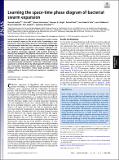Learning the space-time phase diagram of bacterial swarm expansion
Author(s)
Jeckel, Hannah; Jelli, Eric; Hartmann, Raimo; Singh, Praveen K.; Mok, Rachel V. (Rachel Verla); Totz, Jan Frederik; Vidakovic, Lucia; Eckhardt, Bruno; Dunkel, Jorn; Drescher, Knut; ... Show more Show less
DownloadPublished version (1.977Mb)
Terms of use
Metadata
Show full item recordAbstract
Coordinated dynamics of individual components in active matter are an essential aspect of life on all scales. Establishing a comprehensive, causal connection between intracellular, intercellular, and macroscopic behaviors has remained a major challenge due to limitations in data acquisition and analysis techniques suitable for multiscale dynamics. Here, we combine a high-throughput adaptive microscopy approach with machine learning, to identify key biological and physical mechanisms that determine distinct microscopic and macroscopic collective behavior phases which develop as Bacillus subtilis swarms expand over five orders of magnitude in space. Our experiments, continuum modeling, and particle-based simulations reveal that macroscopic swarm expansion is primarily driven by cellular growth kinetics, whereas the microscopic swarming motility phases are dominated by physical cell–cell interactions. These results provide a unified understanding of bacterial multiscale behavioral complexity in swarms. ©2019 National Academy of Sciences Keywords: collective behavior; swarming; cell–cell interactions; microbiology; biofilm
Date issued
2019-01Department
Massachusetts Institute of Technology. Department of Mathematics; Massachusetts Institute of Technology. Department of Mechanical EngineeringJournal
Proceedings of the National Academy of Sciences of the United States of America
Publisher
National Academy of Sciences
Citation
Jeckel, Hannah, et al. "Learning the Space-Time Phase Diagram of Bacterial Swarm Expansion". Proceedings of the National Academy of Sciences 116, 5 (Jan. 2019): p. 1489-1494; DOI: 10.1073/pnas.1811722116 ©2019 Author(s)
Version: Final published version
ISSN
1091-6490